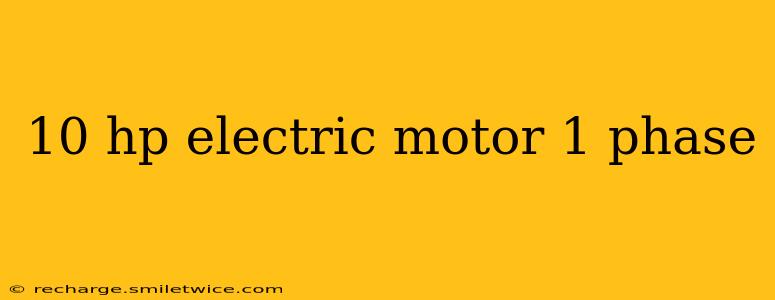Finding the right electric motor for your needs can be a daunting task, especially when dealing with higher horsepower ratings like 10 HP. This guide focuses specifically on 10 HP, single-phase electric motors, exploring their applications, specifications, and considerations for selection. We'll delve into frequently asked questions to help you make an informed decision.
What are the Applications of a 10 HP 1-Phase Electric Motor?
10 HP single-phase electric motors are powerful enough for a variety of demanding applications, but their use is often limited by the inherent power limitations of single-phase power supplies. They are generally suitable for:
-
Industrial Machinery: While less common than three-phase motors for this purpose, they might power smaller industrial equipment like compressors, pumps (especially smaller centrifugal pumps), conveyors, and specialized machinery in situations where three-phase power isn't readily available.
-
Agricultural Equipment: Smaller agricultural applications might utilize a 10 HP single-phase motor, but again, three-phase power is generally preferred for larger-scale farming operations.
-
Heavy-Duty Tools: Certain heavy-duty tools, particularly those used in workshops or construction, may incorporate a 10 HP single-phase motor. Think of large woodworking planers or specialized metal-working equipment.
-
Water Pumping: While larger pumps often require three-phase power, some high-capacity single-phase pumps can operate on 10 HP motors, particularly for residential or smaller commercial applications.
It's crucial to remember that the availability and suitability of a 10 HP single-phase motor depend heavily on the specific application and the electrical infrastructure available. Three-phase power is often a more efficient and practical option for higher horsepower demands.
What are the Different Types of 10 HP 1-Phase Electric Motors?
Several motor types can achieve a 10 HP output in a single-phase configuration, each with its own advantages and disadvantages:
-
Induction Motors: These are the most common type. They are relatively simple, robust, and require less maintenance. However, they might have slightly lower efficiency compared to other types. Within induction motors, you'll find variations like capacitor-start, capacitor-run, and permanent-split capacitor motors, each offering different starting torque characteristics.
-
Synchronous Motors: These motors run at a constant speed regardless of load, but they are generally more complex and expensive than induction motors. They are less frequently used for 10 HP single-phase applications.
-
Universal Motors: While capable of operating on both AC and DC power, their use at 10 HP is uncommon due to potential brush wear and maintenance concerns at such high power levels.
What are the Key Specifications to Consider When Choosing a 10 HP 1-Phase Motor?
Choosing the right motor involves paying close attention to these crucial aspects:
-
Voltage and Frequency: Ensure compatibility with your power supply (e.g., 120V or 240V, 50Hz or 60Hz). Incorrect voltage can damage the motor.
-
Full Load Amps (FLA): This indicates the motor's current draw under full load. It's vital to check if your electrical system can handle this amperage.
-
Starting Torque: This refers to the motor's ability to start under load. Higher starting torque is crucial for applications with high inertia.
-
Efficiency: Higher efficiency motors save energy and reduce operating costs. Look for motors with high efficiency ratings (often expressed as a percentage).
-
Duty Cycle: This defines how long the motor can operate continuously without overheating. Match the duty cycle to the intended use.
-
Mounting: Consider the mounting style (foot-mounted, face-mounted, etc.) required for your application.
How Much Does a 10 HP 1-Phase Electric Motor Cost?
The cost of a 10 HP single-phase motor varies considerably based on the motor type, brand, features (such as efficiency rating), and supplier. Expect a significant investment, potentially several thousand dollars, especially for higher-efficiency models. It's always advisable to obtain quotes from multiple suppliers before making a purchase.
What are the Safety Precautions When Using a 10 HP 1-Phase Electric Motor?
High-power motors like this pose safety risks if not handled correctly. Always adhere to these precautions:
-
Proper Wiring and Installation: Engage qualified electricians for installation to avoid electrical hazards.
-
Grounding: Ensure proper grounding to prevent electric shocks.
-
Overload Protection: Use appropriate overload protection devices to prevent motor damage from excessive current.
-
Safety Guards: Use safety guards to prevent accidental contact with moving parts.
-
Regular Maintenance: Regular inspection and maintenance will extend the motor's lifespan and prevent potential hazards.
This comprehensive guide should provide a solid foundation for understanding 10 HP single-phase electric motors. Remember to consult with qualified electricians and motor specialists for specific advice tailored to your application and local regulations.
